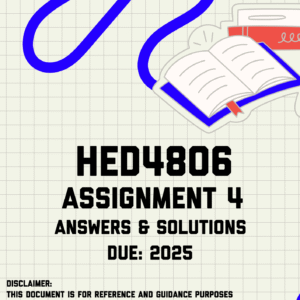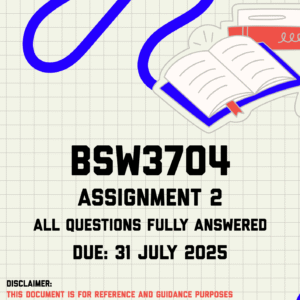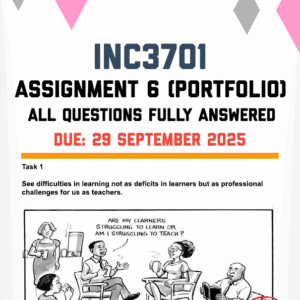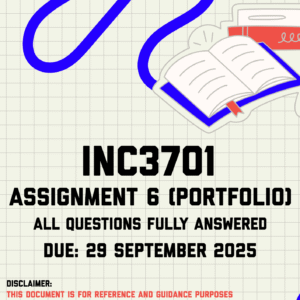Description
INC3701 Assignment 3 2024 | Due 25 June 2024
Question 1
1.1 Explain to a novice educator on, what does a one size fits all approach mean in teaching.
1.2 Why have some researchers questioned the effectiveness of a one-size-fits-all approach for image descriptions, particularly for people who are blind or visually impaired (BLV)? Provide specific reasons mentioned in the passage to support your answer.
1.3 Explain why adopting a one-size-fits-all approach to teaching is criticised and how it may result in inequality of access, participation, and outcomes for learners.
1.4 Discuss the limitations of current automated techniques for generating image descriptions, as highlighted in the article. Provide evidence from the passage to support your answer.
1.5 Explain the two broad categories of technologies mentioned in the passage, which are used to deliver image descriptions. Provide examples for each category.
1.6 What is the aim of investigating the influence of context on image descriptions for people who are BLV, as mentioned in the passage? Provide examples of context-aware solutions highlighted in the passage and explain how context is utilised to enhance the usefulness of image description.
Question 2
2.1 What initially concerned Rosie’s teacher about her behaviour at school and how did the teacher attempt to address the issue? [5]
2.2 Describe the environment in which Rosie lives and the potential factors contributing to her distress at school. [5]
2.3 How did Rosie’s mother and teacher attempt to identify the source of Rosie’s emotional distress and what revelation helped them understand the root cause? [5]
2.4 Explain the significance of the revelation about Rosie’s father being a police officer and the potential threat he faced from a local gang. How did this information impact Rosie’s emotional well-being? [5]
2.5 Discuss the strategies employed by Rosie’s parents and teacher to address her fears and reassure her. How did communication plans contribute to easing Rosie’s concerns?
Question 3
3.1 How do Bontle, Lesiba and Thato demonstrate that there is no single “correct” way to study?
3.2 Explain the reciprocal interaction between innate learner differences and the learning environment, as mentioned in the passage. How does this interaction influence the ways in which learners make meaning from their learning?
3.3 In what ways does the concept of “normal” in education, particularly the bell-curve model, fail to address the diverse needs of learners according to the passage? Provide examples to support your answer.
3.4 Discuss the significance of the shift in thinking mentioned in the passage, where “diversity is the new normality.” How is this shift challenging traditional educational concepts and what implications does it have for teaching and learning in diverse classrooms?
3.5 According to Hart (2004), why does real equity in learning become possible when young people’s school experiences are not organised based on judgments of ability? Elaborate on the implications of this perspective for achieving equity for diverse learners.
Question 4
It’s important for teachers to understand and respect the diversity within the LGBTQ community, to create an inclusive and supportive learning environment for all learners.
4.1 Arrange the terms in the acronym LGBTIQ to explain each one and assist novice teachers in understanding learners’ sexual orientation and gender identity.
4.2 Ubuntu philosophy fosters a supportive and inclusive environment for gender and sexual diverse (LGBTIQ) learners in a school environment. Outline specific strategies that a school’s management team can implement to incorporate Ubuntu principles in addressing and responding to incidents of bullying.












Reviews
There are no reviews yet.